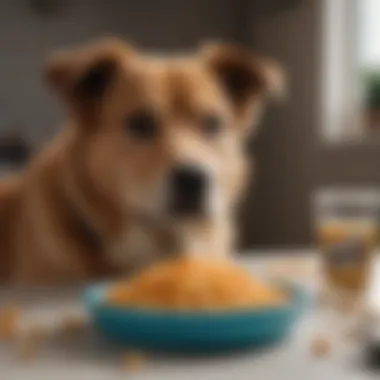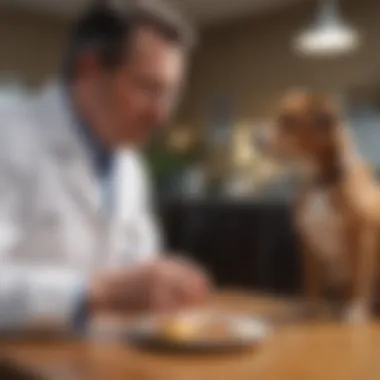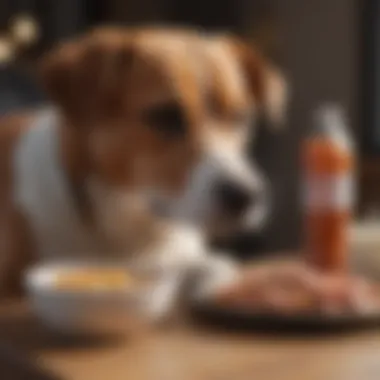Essential Dietary Tips for Dogs with Diarrhea


Intro
When your dog experiences diarrhea, it can be distressing for both you and your pet. Understanding how to adjust their diet appropriately during this time is crucial for a swift recovery. Diarrhea can stem from various causes, and while it often resolves on its own, the right food can support your dog's health.
This article explores what to feed a dog when diarrhea occurs, ensuring you are well-informed on suitable dietary options, preparation methods, and when to seek veterinary care. With this knowledge, you can make confident choices that promote your dog’s well-being.
Understanding Your Pet
Breed Traits
Different dog breeds may have unique dietary needs or sensitivities that can affect their response to digestive issues like diarrhea. For instance, small breeds like Chihuahuas might be more prone to gastrointestinal upset compared to larger breeds like Labrador Retrievers. Understanding your dog's breed traits can guide you in selecting the proper foods during this time.
Common Temperaments
The temperament of your dog can also influence how they handle dietary changes. An anxious dog may react differently than a more laid-back breed. Observing these behaviors helps tailor your approach in soothing your pet during recovery.
Special Needs
Some dogs may have special dietary needs, especially if they are suffering from underlying health conditions. Dogs with pancreatitis, for example, require low-fat diets. If your dog has any chronic health issues, consult your veterinarian before changing their food.
Pet Care Essentials
Nutrition and Feeding Guidelines
When a dog has diarrhea, it is often recommended to switch to a bland diet. Foods like boiled chicken, rice, and pumpkin are gentle on the stomach. Gradually reintroducing regular food can help ease their digestive system back to normal.
- Bland diet options:
- Boiled, skinless chicken
- White rice
- Plain pumpkin
- Boiled potatoes, without skin
Health and Wellness
Monitoring your dog’s hydration is essential during episodes of diarrhea. Ensure they have access to fresh water, as dehydration can quickly become a serious issue. You may also consider electrolyte solutions designed for pets, after consulting with a vet.
Grooming Tips and Techniques
During this time, it’s important to maintain grooming habits. Clean up accidents promptly to prevent skin irritation. A gentle coat cleaning can help ease any discomfort your dog might feel.
Training and Behavior
Basic Training Techniques
Maintaining consistent training routines can help your dog feel more secure, especially when they are not at their best. Using positive reinforcement while adjusting their feeding can foster a supportive environment.
Behavioral Problems and Solutions
Some dogs may exhibit anxiety or stress when unwell. Spend extra time comforting them, and try to avoid disruptions in their routine as much as possible.
Engaging with Your Pet
Safe Outdoor Activities
While your dog is recovering, limit their outdoor activities. Short, gentle walks might be appropriate, but avoid rigorous exercise until their condition stabilizes.
Pet Adoption and Integration
Choosing the Right Pet for Your Lifestyle
If you are considering bringing a new dog into your home, it is essential to understand their specific needs and how they may experience issues like diarrhea. Some breeds can be more susceptible than others. Research carefully to find the right fit.


Conclusion: Managing a dog's health during episodes of diarrhea involves careful attention to their dietary needs. Always consider consulting a veterinarian if you are unsure, particularly if symptoms persist. The health of your pet should always come first.
Understanding Diarrhea in Dogs
Diarrhea in dogs is a symptom that often raises concern for pet owners. Understanding its implications is crucial for effective management and recovery. Recognizing the causes, symptoms, and concerns linked to dog diarrhea helps owners make informed dietary choices and provides a clearer path toward recovery.
Causes of Dog Diarrhea
Dog diarrhea can stem from various sources. Nutrition-related issues, such as a change in diet or consumption of indigestible materials, are common triggers. Bacterial and viral infections can also lead to gastrointestinal upset. Here are some frequent causes:
- Dietary indiscretion: Dogs are often curious and may eat something they shouldn't.
- Food allergies: Certain ingredients can provoke digestive disturbances.
- Infections: Parasitic or viral infections can disrupt gut health.
Understanding these triggers is key to preventing future episodes and ensuring a balanced diet for your animal.
Symptoms to Monitor
Monitoring your dog’s condition is vital. Not just diarrhea, but accompanying symptoms can indicate the severity of the situation. Common symptoms that owners should keep an eye on include:
- Frequent bowel movements: An increase in frequency may signal an issue.
- Blood in stool: This is a serious concern, requiring immediate veterinary attention.
- Vomiting: This may suggest a more complicated health issue.
- Lethargy: If a dog is less active than usual, it could signify distress.
If any of these symptoms occur along with diarrhea, consult your veterinarian.
When Diarrhea Becomes a Concern
While occasional diarrhea is common in dogs, there are specific signs that signal when it is time to take action. Here are some indicators:
- Duration: If diarrhea persists for more than 24 hours, intervention is essential.
- Dehydration signs: Watch for excessive thirst or dry gums, which indicate dehydration.
- Underlying health conditions: Dogs with existing health issues may need more immediate care.
Early recognition of these warning signs plays a critical role in your dog’s recovery and overall health.
Immediate Dietary Adjustments
Immediate dietary adjustments are crucial when a dog experiences diarrhea. Encounters with diarrhea can be distressing for both the dog and the owner, and managing the diet promptly avoids further complications. A careful choice of food can soothe the digestive system while helping re-establish a healthy balance. The adjustments made in the dog’s diet must be strategic, as they can influence recovery times and overall health.
Bland Diet Essentials
A bland diet is often the first recommendation when dealing with a dog’s diarrhea. This type of diet limits ingredients that can irritate the digestive system. The primary goals of a bland diet are to stabilize the gastrointestinal tract and provide easily digestible nutrients. Key components to include in this diet generally consist of boiled chicken, white rice, and pumpkin. These foods have gentle textures and are less likely to trigger any adverse reactions.
The gradual introduction of these foods helps to ensure that the dog can tolerate them. It is wise to monitor the dog’s condition closely during this time, adjusting the diet as necessary depending on their response. Feeding small, frequent meals rather than large amounts can also be beneficial.
Recommended Food Choices
Boiled Chicken
Boiled chicken is a staple in the bland diet for dogs. It is easy to digest and provides good protein without causing irritation to the stomach. The main characteristic of boiled chicken is its low-fat content. This makes it less taxing on the gastrointestinal system. The unique feature of boiled chicken is its simplicity; it does not include any seasoning or additives, which helps avoid further digestive upset.
However, the disadvantage could be that it lacks variety and should not be the only food given for too long. Lean protein should not be the sole component for a dog’s long-term diet. But for recovery, it remains a popular and effective choice.
White Rice
White rice is another recommended food for dogs with diarrhea. Its role is significant, as it acts as a binding agent, which can help firm up stools. The key characteristic of white rice is its carbohydrate content, which provides a quick source of energy. This is particularly useful when dogs do not eat much due to gastrointestinal distress.
White rice's unique feature is its high starch level, which helps absorb excess water in the intestines. This can lead to quicker recovery. One disadvantage, though, is that too much rice over time can lead to a lack of certain nutrients, since it doesn’t provide balanced nutrition on its own.
Pumpkin
Pumpkin is often overlooked but can be a valuable addition to a dog’s diet during episodes of diarrhea. It is rich in fiber, which helps bulk up the stool and regulates bowel function. The essential characteristic of pumpkin is its soluble fiber, which aids digestion and can help manage diarrhea effectively.
What makes pumpkin unique is its nutrient density, as it contains vitamins and minerals. Regularly adding pumpkin to a dog’s diet can support overall digestive health. However, using too much pumpkin might lead to constipation if not monitored properly. Therefore, moderation is always key.
Foods to Avoid


When considering foods to give your dog during diarrhea, it is equally essential to know what to avoid. Common irritating foods include dairy products, fatty meats, and any heavily spiced items. These foods can worsen a dog's gastrointestinal issues and should be completely omitted during this recovery phase.
In addition, certain grains, like whole grains, can also pose a challenge, as they may be harder to digest. Always contact a veterinarian if unsure about particular foods. Keeping the dog’s diet simple and clean is fundamental during this delicate period.
Hydration and Electrolyte Balance
Maintaining hydration status is vital when a dog suffers from diarrhea. Diarrhea often causes a significant loss of fluids and electrolytes. If left untreated, this can lead to dehydration, which is a serious condition that can affect the dog's overall health. Dogs may readily lose both water and essential minerals, leading to imbalances that can impede physiological functions.
Proper hydration helps to support the functions of the heart, kidneys, and muscles. It aids in digestion and helps to maintain healthy skin. Ensuring your dog stays hydrated not only facilitates recovery but also prevents further complications. Always observe for changes in drinking behavior; if a dog drinks less water or shows signs of lethargy, it is crucial to address these issues promptly.
Importance of Hydration
Fluid intake is critical during diarrhea. Water remains the most essential component. A dog needs constant access to fresh water to drink. Dehydration can show signs such as dry gums, increased heart rate, or loss of skin elasticity.
Signs may include:
- Dry nose or gum: These areas should be moist.
- Sunken eyes: This can reflect dehydration.
- Lethargy: Reduced energy levels.
Additionally, offering water in small amounts can be beneficial. Large quantities may upset the stomach further. If the dog refuses water, it may be necessary to entice them by providing ice chips or adding low-sodium chicken broth to their water. These methods can stimulate interest in drinking.
Homemade Electrolyte Solutions
Creating a homemade electrolyte solution can be helpful. It can assist in replenishing lost minerals and fluids. A simple recipe requires just a few ingredients that are commonly found at home. Here’s how to make one:
Recipe:
- Ingredients:
- Preparation:
- 1 quart of water
- 1 teaspoon of salt
- 1 tablespoon of honey or sugar
- Mix the ingredients until fully dissolved.
- Offer the solution to your dog gradually.
This solution can help in rebalancing electrolytes and sodium levels. However, always consult your veterinarian before introducing any new solutions or changes to your dog's hydration strategy. They can provide tailored advice based on your dog’s condition and needs.
Important: Be careful not to supply high-sugar drinks, as they can worsen diarrhea.
Understanding the relationship between hydration and health can significantly aid in the recovery of a dog experiencing diarrhea. Monitoring water intake and considering homemade electrolyte solutions can be pivotal steps in this process.
Food Preparation Methods
Understanding how to properly prepare food for a dog experiencing diarrhea is a crucial aspect of their recovery. It's vital to realize that not just any food will do. The right preparation methods can significantly influence a dog's gut health and overall well-being. The objective here is to create meals that are easy to digest, allowing for a swift recovery from gastrointestinal distress.
Cooking for Your Dog
When dealing with a dog that has diarrhea, cooking their meals is highly recommended. Raw foods can exacerbate the issue, and cooking helps eliminate potential pathogens that could worsen diarrhea. Focus on simple, wholesome ingredients for the cooked meals. Here are key points to consider:
- Lean Proteins: Use boiled chicken or turkey. Remove all skin and bones. These proteins are easy on the stomach.
- Carbohydrates: Incorporating white rice or sweet potatoes can provide energy while being gentle on the digestive system.
- How to Cook: Boil the proteins and then mix them with the carbohydrates. Avoid adding any seasonings or fats, as these can irritate the gastrointestinal tract.
It's also important to monitor portion sizes. Start with small amounts to see how your dog responds. If they tolerate it well, gradually increase the quantity.
Incorporating Probiotics
Probiotics play a significant role in restoring gut flora and can be beneficial during episodes of diarrhea. By reintroducing healthy bacteria, probiotics can assist in stabilizing the digestive system. There are various forms of probiotics available:
- Commercial Products: Look for high-quality probiotic supplements designed specifically for dogs. Brands like FortiFlora or Proviable can be effective. Consult your veterinarian for recommendations.
- Natural Sources: You can also opt for natural sources of probiotics, such as plain, unsweetened yogurt. Ensure it does not contain artificial sweeteners like xylitol, which are toxic to dogs.
Introducing probiotics should be done gradually. Start with a small amount mixed into their food and observe their response. If your dog seems to handle the new addition well, slowly increase the dose as per the product’s instructions.
Effective food preparation methods and the incorporation of probiotics can greatly aid a dog's recovery process.


Gradual Reintroduction to Regular Diet
Gradually reintroducing your dog to its regular diet is a crucial step after an episode of diarrhea. After a period of eating bland food, transitioning back to a normal diet needs to be done carefully. This can help to prevent the recurrence of digestive issues. The process requires attention and patience, allowing your dog's body to adjust. A sudden return to regular food can overwhelm the digestive system, potentially causing further discomfort. Following a structured approach makes the transition smoother and safer.
Understanding Transition Times
The transition time for your dog's diet can vary depending on several factors such as the dog's condition, age, and dietary history. Typically, it is advisable to start reintroducing regular food after 2 to 3 days of improvement in stool consistency. Start slowly by mixing a small amount of regular dog food with the bland diet. Typically, you would use about 25% regular food to 75% bland food initially. Gradually increase the regular food portion over three to five days. This slow increase allows time for the digestive system to adapt.
Keep an eye on how your dog responds during this phase. If any signs of diarrhea appear again, it might be wise to backtrack to the bland diet and consult with a veterinarian. Each dog's timeline may differ, so monitor closely and adjust accordingly.
Monitoring Response to Regular Foods
As you reintroduce your dog's regular diet, it is essential to pay close attention to their reactions. Look for any signs of indigestion or discomfort, such as excessive gas, bloating, or changes in stool consistency. This monitoring will give insight into how well your dog is adapting to the regular food.
When beginning with regular dog food, consider the following:
- Watch for Symptoms: Look for any signs of digestive upset. If diarrhea returns, stop feeding regular food and revert to bland options.
- Adjust Portions: Depending on their response, you may need to adjust how much regular food you are offering.
- Quality of Food: Ensure the regular food is of high quality that suits your dog's dietary needs. Foods with real meat, whole grains, and no excessive fillers are recommended.
Taking these steps provides a template to follow while every dog's needs might slightly differ. Consulting a veterinarian for tailored advice can be beneficial in monitoring and ensuring that your pet recovers well.
When to Consult a Veterinarian
Determining when to seek professional help for a dog experiencing diarrhea is crucial for the health and well-being of your pet. Diarrhea, while common, can indicate a serious underlying condition. Recognizing when it is necessary to consult a veterinarian can make a significant difference in your dog’s health and recovery process. Timely vet visits can lead to more accurate diagnoses and appropriate treatments, minimizing the risks of complications.
Regular monitoring of your dog’s symptoms and condition is vital. If the diarrhea persists for more than 24 hours or occurs alongside other troubling symptoms, a consultation with a veterinarian should be prioritized. They can provide professional insight into whether your dog needs immediate care or can manage the situation at home. More importantly, this step can prevent dehydration and further health issues down the line.
Indicators of Serious Conditions
Not all cases of diarrhea require veterinary intervention, but certain indicators signal a more serious condition. Look out for the following symptoms:
- Blood in Stools: The presence of blood is alarming and often suggests a serious underlying health issue.
- Vomiting: Frequent vomiting can lead to dehydration and may point to gastrointestinal issues that require medical attention.
- Lethargy: If your dog appears unusually tired or unresponsive, it could indicate a more severe problem.
- Signs of Pain: Watch for whining, whimpering, or signs of discomfort when touched.
- Fever: An elevated temperature may indicate infection or inflammation.
- Duration: Diarrhea lasting more than 24 hours should not be ignored.
Promptly addressing these symptoms can save your dog from further health decline. It is better to err on the side of caution when your pet’s well-being is at stake.
Preparing for the Vet Visit
When preparing for a veterinarian visit, ensure you have all essential information at hand. This preparation allows the vet to assess your dog's condition more effectively. Here’s how to get ready:
- Keep Records: Document the duration and nature of the diarrhea, as well as any other symptoms you have observed.
- Note Dietary Changes: Inform the vet about any dietary adjustments you made. This includes recent treats or new foods introduced.
- Hydration Status: Mention if your dog has had difficulty staying hydrated.
- Collect Samples: If possible, bring a stool sample to help the vet analyze the issue more thoroughly.
- List Medications: Provide a list of any medications your dog is currently taking, as some can contribute to digestive issues.
Consulting with a veterinarian at the right time can lead to improved outcomes for your dog. Do not hesitate if you detect any concerning signals.
Taking the time to prepare can streamline the consultation, making it more productive and ensuring your dog receives the necessary care without delay.
Preventive Measures for Future Episodes
Pet owners must understand the relevance of preventive measures in maintaining a dog’s health, especially regarding diet and digestive health. Prevention not only reduces the likelihood of diarrhea but also enhances overall well-being. By identifying triggers and adopting appropriate dietary adjustments, one can mitigate serious health issues in the future. Here, we explore two critical aspects of prevention: identifying food allergies and maintaining digestive health.
Identifying Food Allergies
Food allergies in dogs are common but often overlooked. Recognizing these allergies is crucial for preventing episodes of diarrhea. Symptoms can vary widely, including gastrointestinal upset, skin irritations, or behavioral changes. Owners should carefully monitor their dog's reactions to new foods or treats. To identify specific allergens, an elimination diet may be helpful. This method involves withholding all potential allergens for a period, then slowly reintroducing them one at a time. This approach helps in pinpointing the culprit behind any adverse reaction.
- Common allergens in dog food include:
- Beef
- Dairy products
- Chicken
- Wheat
- Eggs
- Soy
Keeping a food diary may aid in tracking your dog’s diet and any signs of allergies. If you suspect a food allergy, consulting with a veterinarian for further tests and guidance is advisable. The goal is to find a suitable diet that avoids allergens while still providing essential nutrients.
Maintaining Digestive Health
A stable digestive system is key to preventing diarrhea in dogs. This can be achieved by incorporating probiotics into their diet. Probiotics help maintain a healthy balance of gut bacteria, which is essential for efficient digestion. Foods rich in natural probiotics include plain yogurt and fermented products specifically formulated for dogs.
In addition to probiotics, the following strategies improve digestive health:
- Regular feeding schedule: Consistency helps regulate digestive processes.
- Fibre-rich foods: Certain types of fiber can promote healthy digestion and stool consistency. Look for sources like pumpkin or sweet potatoes.
- Fresh water access: Always provide clean, fresh water to maintain hydration and assist digestion.
Maintaining a balanced diet and good hydration can significantly reduce the risk of diarrhea.



